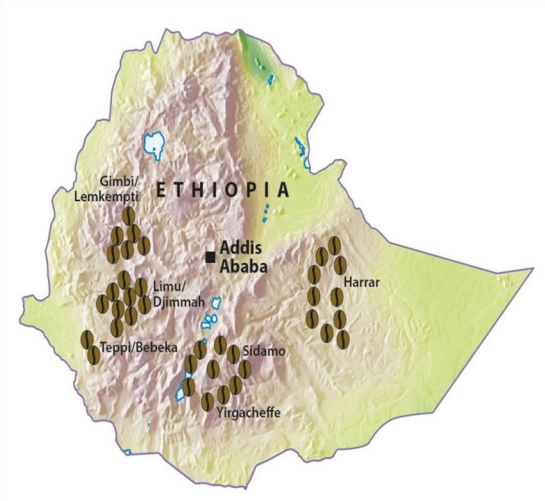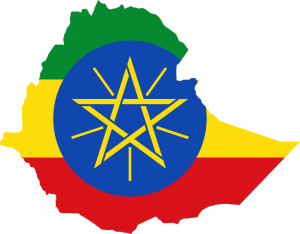Ethiopia Djimmah
About Ethiopia and its Coffee Production
Ethiopia is the birthplace of coffee: it is in the forests of the Kaffa region that coffee arabica grew wild.
Ethiopian coffees are available from some regions as dry-processed, from some regions as washed, and from Sidamo as both.
Kaffa (Kefa) is a province on the southwestern side of Ethiopia; its capital city was Bonga. It was named after the former Kingdom of Kaffa. The etymology of Kaffa is thought to be from the Arabic word qahwah meaning “a drink from berries”. The English word coffee is derived from the same root.
Where does the Ethiopia Djimmah come from?
The catchment area for Ethiopian Mocha Djimmah is the largest in Ethiopia. These coffees are well known for their body and acidity. Djimmah is grown in the Illubabor and Kaffa regions of Ethiopia at elevations from 4,400 to 6,000 feet above sea level within the biggest catchment area in Ethiopia, an area that produces and exports about 60,000 tons of coffee each year. Djimmah is also called Jimma Coffee. A unique coffee thought to be the variety closest in flavour to the original wild plant. This is an ideal climate and the plants are well protected by the larger forest trees which provide shade from the midday sun and preserve the moisture in the soil.
Coffee from Ethiopia is known for its bright fruited and floral flavours. These coffees typically have a higher acidity, light to medium body and complex flavour notes.
The beans are either washed or naturally processed. The processing method used has a huge impact on the final taste of the coffee.


Unwashed (Natural Dry Processed) vs Washed
There is a significant difference in the cup profiles between the natural dry processed and the washed.
Washed Sidamo, Yirgacheffe and Limu have a lighter body and less earthy/wild tastes in the cup as their dry-processed relations.
Ethiopian Djimmah is a dry-processed coffee.
The dry process, also known as unwashed or natural coffee, is the oldest method of processing coffee. The entire cherry after harvest is first cleaned and then placed in the sun to dry on tables or in thin layers on patios.
Cleaning: The harvested cherries are usually sorted and cleaned, to separate the unripe, overripe and damaged cherries and to remove dirt, soil, twigs and leaves.
Drying: The coffee cherries are spread out in the sun, either on large concrete or brick patios or on matting raised to waist height on trestles. As the cherries dry, they are raked or turned by hand to ensure even drying and prevent mildew. It may take up to 4 weeks before the cherries are dried to the optimum moisture content, depending on the weather conditions. The drying operation is the most important stage of the process since it affects the final quality of the green coffee. A coffee that has been overdried will become brittle and produce too many broken beans during hulling. Coffee that has not been dried sufficiently will be too moist and prone to rapid deterioration caused by the attack of fungi and bacteria.
The dried cherries are stored in bulk in special silos until they are sent to the mill where hulling, sorting, grading and bagging take place. All the outer layers of the dried cherry are removed in one step by the hulling machine.
Does Ethiopian coffee have more caffeine?
For example, Ethiopian coffee is 1.13 per cent caffeine, while Tanzanian coffee is 1.42 per cent caffeine. The popular Arabica bean only contains 1.5 per cent caffeine, while the strongest bean, the Robusta bean, is 2.4 per cent caffeine.
Tasting Notes for Ethiopia Djimmah
| Country of Origin | Ethiopia |
| Screen Size / Grade | Screen 14/17, Grade 5 |
| Bean Appearance (green) | Mixed visual, variable sizes, variable colour denoting natural process |
| Acidity | Light |
| Body | Medium |
| Bag Size | 60kg |
| Harvest Period | October – March |
| Description | Using the natural process, the bean presents an intense mild bean with sweet fruit and a wine-like dimension. A lively, dry process experience that strongly represents its origin roots. |
| Tasting Notes | Intense sweetness with wine-like notes. Rich body, deeply aromatic with a complex earthy finish. |
| Strength | |
| Processing Method | Natural (Dry Processed) |
| Altitude | 1,300 to 1,800 MASL |
History of Coffee in Ethiopia
Ethiopia is widely considered the birthplace of coffee. Many experts say that Ethiopia is the only place that coffee grew natively and the apocryphal story of Kaldi is told over and over. Kaldi was a goat herder who discovered coffee after witnessing the vigour that his goats received from eating the cherries.
He later brought these cherries to the monastery and shared them with the monks who exclaimed that they were the Devil’s work and hurled them into the fire. The aroma of the beans roasting in the fire was heavenly and the beans were raked from the fire and crushed to put out the embers. Realizing their mistake, they placed them into a jug and covered them with hot water for preservation. Later the monks drank the brew and it helped them keep awake during nightly devotions.
While this story is fun, in all actuality, it was likely that the people of the nomadic Galla tribe first discovered the coffee plant and its invigorating properties. Many such stories about the origin of coffee are apocryphal and its actual discovery is something of much speculation.
The rest of the coffee’s history in Ethiopia is quite turbulent. Ethiopia has undergone many changes in its government. In the past 40 years alone, they have had three forms of government, from a militaristic Marxist ideology to the federal system today. Each of these systems has been met with much public dissatisfaction, rebellion, and political upheaval. From 1998-2000 Ethiopia was involved in a war with Eritrea. This conflict with Eritrea (and much other dissension) have led to many deaths and great misery. It also limited access to land and created an economic downturn. The cost of the war was estimated at billions of dollars.
Amidst the turbulent political and economic climate, coffee farming in Ethiopia took a big hit. In 2003, the price of coffee plummeted lower than it ever has. The price of coffee was no longer covering the cost of production and, as a result, many farmers abandoned their crops. They were devastated, not having enough money to cover the cost of repairs to their homes, purchase clothing, or provide their children with an education. Many farmers migrated away from their farms to the city while others still remained with their coffee plantations.
Despite all of these hardships and challenges, coffee remains Ethiopia’s biggest export. At times, Ethiopian coffee farmers must compete and pair with larger companies with more power that often take most of the profit. Farmers make very little from these partnerships and women in Ethiopia’s coffee industry make even less, sometimes as little as 20USD a month. In 1957, the National Coffee Board of Ethiopia was formed to help improve the quality of Ethiopian coffee and to coordinate producers traders and exporters. And recently, Fair Trade organizations have been helping to ensure the fair compensation of coffee producers.
Ethiopia is now the world’s seventh-largest producer of coffee, and Africa’s top producer, with 260,000 metric tonnes in 2006.
Half of the coffee is consumed by Ethiopians, and the country leads the continent in domestic consumption.
Interested in some Djimmah?
Visit our Djimmah page or Espresso Bar to buy a bag of our Ethiopia Djimmah.
